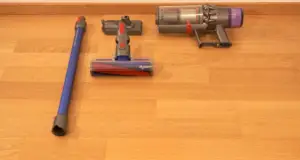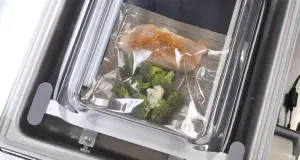A Question That Gets Asked a Lot
Do vacuum sealers really work? It is a question that gets asked a lot in the food industry and by the housewives and restaurant cooks as well. And the answer is surprisingly obvious. Yes. Vacuum sealers do work.
Now, how exactly do they work? I am going to go over their working principle in length in this blog. After reading it you will know the exact workings of a vacuum sealer and its various functions and types.
Here we go.
What is Vacuum
In order to understand the ‘how’ of vacuum sealers, first we have to understand the vacuum. According to britannica website vacuum is any space where the pressure is so low that any particles within that space are not affected by any processes being carried out on them.
Vacuum is achieved by lowering the atmospheric pressure in that space well below normal atmospheric pressure. You may recall it to be 14 pounds per square inch at sea level. Meaning, that anywhere near sea elevation, the column of air surrounding one square inch of earth exerts a force equal to 14 pounds on that square inch of sand. So, in order to create a vacuum, one just removes the air on top of that square inch of soil. As air is removed, there is no weight of air in that column pushing down. No weight means no downward force.
Now, you may ask how exactly one pushes the air away from that area. Simply sucking that air away. But, won’t that allow the air nearby to fill that space? Yes. But it is here the sealing part of vacuum sealers comes in. They block the surrounding air from filling in the gap caused by removal of air.
Vacuum Sealers
So far, I have covered what is vacuum and how it is created and how it is maintained. Let us now move on to vacuum sealers. As the name suggests; vacuum sealer is any equipment which uses the principle of sucking the air out of a storage container and sealing its mouth to avoid future re-entry of air into it. The sucking used to draw the air out of the bag is too low to cause any crushing or loss of juice(s) of the stored food thus preserving it for a very long time compared to simple refrigeration.
Vacuum sealer is used to seal any food item. Be it meat, vegetables, fruit and even meals. Fresh frozen produce such as peas, peppers, blueberries, strawberries , broccoli, green beans, kale etc can be stored for months in clear vacuum sealed bags.
Why not Ziplock
One may ask why not just put the item in question in a ziplock bag and store it in the freezing compartment of the refrigerator? It is a good question but you may have guessed the answer already. Because, a ziplock’s seal is inadequate for no re-entry of air for long periods of time. Air, really cold air of the freezer may enter through the ziplock causing the stored item to freeze burn, thus spoiling it and making it non-consumable.
In the table below, you can see the clear difference between normal refrigeration and vacuum sealing of various food items.
| Food Item | Refrigerated | Vacuum Sealed |
| Berries | 1 month | 1 year |
| Mince | 4 months | 1 year |
| Meat | 6 months | 2-3 years |
Types of Vacuum Sealers
Now that we have a firm grasp of the working principle of vacuum sealers, let us move on to various types of vacuum sealers.
Categorically, there are two types of vacuum sealers:
- Chamber Vacuum Sealers
- External Vacuum Machines
I will briefly touch on both of them.
Chamber Vacuum Sealers
Chamber type vacuum sealers have a chamber built inside where one puts the item to be sealed while inside a clear plastic bag and the lid is closed. Air is drawn out of the bag and the lid has a heating mechanism which ensures the bag is sealed upon removal of all air inside the bag. Such sealers are costly on the pocket when purchased, but they seal a wide range of food items, including liquid ones.
External Vacuum Machines
External vacuum machines, on the other hand, do the vacuuming while the item to be vacuumed is outside the machine. They are less costly and are preferred in such places where occasional vacuum sealing with small quantities of food is required.
A Third Kind (of) Vacuum Sealer
There is a third type of sealer as well, sometimes called the pistol-type vacuum sealer. Such types have a hand held device, shaped like a pistol, placed at the mouth of a special bag with a built-in valve to ensure as-needed vacuum sealing. Such sealers are small and portable.
Manual or Automatic
Vacuum sealers, be they chamber or external, come with an either manual or automatic setting. In the manual setting, one is in control of the vacuuming time i.e for how long the air would be sucked out of the bag. Such a feature is great for sealing delicate items like muffins. They allow one to keep the shape of the item intact. In the automatic vacuum sealers, on the other hand, one is in control of the sucking i.e it keeps on drawing the air out of the bag until there is none left inside the bag. Such sealers have fast operating efficiency.
Extra Design Features
Vacuum sealers may come with other design features as well, such as the ability to store a continuous running length of plastic spool which may be cut as needed; a pulse mode of vacuuming, allowing one to control the degree of vacuum; or, gas flushing which replaces oxygen inside the bag with another inert gas usually carbon monoxide or nitrogen.
Cooking and Reheating Vacuum Sealed Foods
As I have shown in the table above, the shelf life of various eatables is greatly enhanced by using vacuum sealers but what good is all that shelf life when one does not know how to cook or reheat it for consumption later?
Vacuum sealing can be used to prepare portioned-meals, which help reduce food waste. Sealed food items can be made ready to eat either by:
- Microwave Oven
- Pot Boiling
- Sous Vide
Microwave Oven
Any food item with less oil in it which was sealed with a microwave safe bag can be put directly in the oven to make it ready to be served. Just make sure to cut a small opening in the bag before putting it in the oven to allow the steam to escape.
Pot Boiling
For food items stored in boil-able vacuum packaging bags, a small pot is an excellent choice. Hot water present in the pot helps make the food ready for consumption. Do keep in mind that the food has already been cooked before sealing, so, higher temperatures and short times is sufficient to make it serve ready.
Sous Vide Cooking
Sous Vide cooking is a fancy name for ‘under vacuum’ cooking in french. It simply means to cook the sealed food in a temperature controlled water bath. Such cooking results in a consistent, repeatable flavor. Any novice can produce great food by sous vide cooking.
Conclusion
So, there you have it, the principle, the working, the types of vacuum sealers. Now, if anyone asks you; do vacuum sealers really work? You know they do. and soon they will.
Happy sealing.




